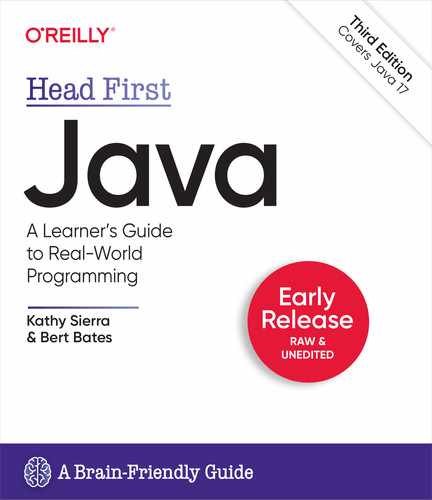Chapter 2. Classes and Objects: A Trip to Objectville

I was told there would be objects. In Chapter 1, we put all of our code in the main() method. That’s not exactly object-oriented. In fact, that’s not object-oriented at all. Well, we did use a few objects, like the String arrays for the Phrase-O-Matic, but we didn’t actually develop any of our own object types. So now we’ve got to leave that procedural world behind, get the heck out of main(), and start making some objects of our own. We’ll look at what makes object-oriented (OO) development in Java so much fun. We’ll look at the difference between a class and an object. We’ll look at how objects can give you a better life (at least the programming part of your life. Not much we can do about your fashion sense). Warning: once you get to Objectville, you might never go back. Send us a postcard.
Chair Wars
(or How Objects Can Change Your Life)
Once upon a time in a software shop, two programmers were given the same spec and told to “build it”. The Really Annoying Project Manager forced the two coders to compete, by promising that whoever delivers first gets a cool Aeron™ chair and adjustable height standing desk like all the Silicon Valley guys have. Larry, the procedural programmer, and Brad, the OO guy, both knew this would be a piece of cake.
Larry, sitting in his cube, thought to himself, “What are the things this program has to do? What procedures do we need?”. And he answered himself , “rotate and playSound.” So off he went to build the procedures. After all, what is a program if not a pile of procedures?
Brad, meanwhile, kicked back at the cafe and thought to himself, “What are the things in this program... who are the key players?” He first thought of The Shapes. Of course, there were other objects he thought of like the User, the Sound, and the Clicking event. But he already had a library of code for those pieces, so he focused on building Shapes. Read on to see how Brad and Larry built their programs, and for the answer to your burning question, “So, who got the Aeron and the desk?”


In Larry’s cube
As he had done a gazillion times before, Larry set about writing his Important Procedures. He wrote rotate and playSound in no time.
rotate(shapeNum) {
// make the shape rotate 360º
}
playSound(shapeNum) {
// use shapeNum to lookup which
// AIF sound to play, and play it
}
At Brad’s laptop at the cafe
Brad wrote a class for each of the three shapes

Larry thought he’d nailed it. He could almost feel the rolled steel of the Aeron beneath his...
But wait! There’s been a spec change.
“OK, technically you were first, Larry,” said the Manager, “but we have to add just one tiny thing to the program. It’ll be no problem for crack programmers like you two.”
“If I had a dime for every time I’ve heard that one”, thought Larry, knowing that spec-change-no-problem was a fantasy. “And yet Brad looks strangely serene. What’s up with that?” Still, Larry held tight to his core belief that the OO way, while cute, was just slow. And that if you wanted to change his mind, you’d have to pry it from his cold, dead, carpal-tunnelled hands.

Back in Larry’s cube
The rotate procedure would still work; the code used a lookup table to match a shapeNum to an actual shape graphic. But playSound would have to change.
playSound(shapeNum) {
// if the shape is not an amoeba,
// use shapeNum to lookup which
// AIF sound to play, and play it
// else
// play amoeba .mp3 sound
}
It turned out not to be such a big deal, but it still made him queasy to touch previously-tested code. Of all people, he should know that no matter what the project manager says, the spec always changes.
At Brad’s laptop at the beach
Brad smiled, sipped his margarita, and wrote one new class. Sometimes the thing he loved most about OO was that he didn’t have to touch code he’d already tested and delivered. “Flexibility, extensibility,...” he mused, reflecting on the benefits of OO.

Larry snuck in just moments ahead of Brad.
(Hah! So much for that foofy OO nonsense). But the smirk on Larry’s face melted when the Really Annoying Project Manager said (with that tone of disappointment), “Oh, no, that’s not how the amoeba is supposed to rotate...”
Turns out, both programmers had written their rotate code like this:
-
determine the rectangle that surrounds the shape
-
calculate the center of that rectangle, and rotate the shape around that point.
But the amoeba shape was supposed to rotate around a point on one end, like a clock hand.

“I’m toast.” thought Larry, visualizing charred Wonderbread™. “Although, hmmmm. I could just add another if/else to the rotate procedure, and then just hard-code the rotation point code for the amoeba. That probably won’t break anything.” But the little voice at the back of his head said, “Big Mistake. Do you honestly think the spec won’t change again?”


Back in Larry’s cube
He figured he better add rotation point arguments to the rotate procedure. A lot of code was affected. Testing, recompiling, the whole nine yards all over again. Things that used to work, didn’t.
rotate(shapeNum, xPt, yPt) {
// if the shape is not an amoeba,
// calculate the center point
// based on a rectangle,
// then rotate
// else
// use the xPt and yPt as
// the rotation point offset
// and then rotate
}
At Brad’s laptop on his lawn chair at the Telluride Bluegrass Festival
Without missing a beat, Brad modified the rotate method, but only in the Amoeba class. He never touched the tested, working, compiled code for the other parts of the program. To give the Amoeba a rotation point, he added an attribute that all Amoebas would have. He modified, tested, and delivered (wirelessly) the revised program during a single Bela Fleck set.

So, Brad the OO guy got the chair and desk, right?
Not so fast. Larry found a flaw in Brad’s approach. And, since he was sure that if he got the chair and desk, he’d also get Lucy in accounting, he had to turn this thing around.
LARRY: You’ve got duplicated code! The rotate procedure is in all four Shape things.
BRAD: It’s a method, not a procedure. And they’re classes, not things.
LARRY: Whatever. It’s a stupid design. You have to maintain four different rotate “methods”. How can that ever be good?
BRAD: Oh, I guess you didn’t see the final design. Let me show you how OO inheritance works, Larry.

You can read this as, “Square inherits from Shape”, “Circle inherits from Shape”, and so on. I removed rotate() and playSound() from the other shapes, so now there’s only one copy to maintain.
The Shape class is called the superclass of the other four classes. The other four are the subclasses of Shape. The subclasses inherit the methods of the superclass. In other words, if the Shape class has the functionality, then the subclasses automatically get that same functionality.
What about the Amoeba rotate()?
LARRY: Wasn’t that the whole problem here — that the amoeba shape had a completely different rotate and playSound procedure?
BRAD: Method.
LARRY: Whatever. How can amoeba do something different if it “inherits” its functionality from the Shape class?
BRAD: That’s the last step. The Amoeba class overrides the methods of the Shape class. Then at runtime, the JVM knows exactly which rotate() method to run when someone tells the Amoeba to rotate.


LARRY: How do you “tell” an Amoeba to do something? Don’t you have to call the procedure, sorry—method, and then tell it which thing to rotate?
BRAD: That’s the really cool thing about OO. When it’s time for, say, the triangle to rotate, the program code invokes (calls) the rotate() method on the triangle object. The rest of the program really doesn’t know or care how the triangle does it. And when you need to add something new to the program, you just write a new class for the new object type, so the new objects will have their own behavior.
The suspense is killing me. Who got the chair and desk?

Amy from the second floor.
(unbeknownst to all, the Project Manager had given the spec to three programmers.)
 Brain Power
Brain Power
Time to pump some neurons.
You just read a story bout a procedural programmer going head-to-head with an OO programmer. You got a quick overview of some key OO concepts including classes, methods, and attributes. We’ll spend the rest of the chapter looking at classes and objects (we’ll return to inheritance and overriding in later chapters).
Based on what you’ve seen so far (and what you may know from a previous OO language you’ve worked with), take a moment to think about these questions:
What are the fundamental things you need to think about when you design a Java class? What are the questions you need to ask yourself? If you could design a checklist to use when you’re designing a class, what would be on the checklist?
When you design a class, think about the objects that will be created from that class t ype. Think about:

Things an object knows about itself are called instance variables. They represent an object’s state (the data), and can have unique values for each object of that type.
Think of instance as another way of saying object.
Things an object can do are called methods. When you design a class, you think about the data an object will need to know about itself, and you also design the methods that operate on that data. It’s common for an object to have methods that read or write the values of the instance variables. For example, Alarm objects have an instance variable to hold the alarmTime, and two methods for getting and setting the alarmTime.
So objects have instance variables and methods, but those instance variables and methods are designed as part of the class.
![]() sharpen your Pencil
sharpen your Pencil
Fill in what a television object might need to know and do.

What’s the difference between a class and an object?

A class is not an object.
(but it’s used to construct them)
A class is a blueprint for an object. It tells the virtual machine how to make an object of that particular type. Each object made from that class can have its own values for the instance variables of that class. For example, you might use the Button class to make dozens of different buttons, and each button might have its own color, size, shape, label, and so on.
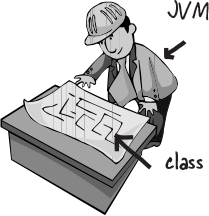
Making your first object
So what does it take to create and use an object? You need two classes. One class for the type of object you want to use (Dog, AlarmClock, Television, etc.) and another class to test your new class. The tester class is where you put the main method, and in that main() method you create and access objects of your new class type. The tester class has only one job: to try out the methods and variables of your new object class type.
From this point forward in the book, you’ll see two classes in many of our examples. One will be the real class – the class whose objects we really want to use, and the other class will be the tester class, which we call <whateverYourClassNameIs> TestDrive. For example, if we make a Bungee class, we’ll need a BungeeTestDrive class as well. Only the <someClassName>TestDrive class will have a main() method, and its sole purpose is to create objects of your new type (the not-the-tester class), and then use the dot operator (.) to access the methods and variables of the new objects. This will all be made stunningly clear by the following examples. No, really.

If you already have some OO savvy, you’ll know we’re not using encapsulation. We’ll get there in Chapter 4.
Making and testing Movie objects

class Movie {
String title;
String genre;
int rating;
void playIt() {
System.out.println("Playing the movie");
}
}
public class MovieTestDrive {
public static void main(String[] args) {
Movie one = new Movie();
one.title = "Gone with the Stock";
one.genre = "Tragic";
one.rating = -2;
Movie two = new Movie();
two.title = "Lost in Cubicle Space";
two.genre = "Comedy";
two.rating = 5;
two.playIt();
Movie three = new Movie();
three.title = "Byte Club";
three.genre = "Tragic but ultimately uplifting";
three.rating = 127;
}
}
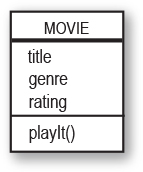
The MovieTestDrive class creates objects (instances) of the Movie class and uses the dot operator (.) to set the instance variables to a specific value. The MovieTest-Drive class also invokes (calls) a method on one of the objects. Fill in the chart to the right with the values the three objects have at the end of main().

Quick! Get out of main!
As long as you’re in main(), you’re not really in Objectville. It’s fine for a test program to run within the main method, but in a true OO application, you need objects talking to other objects, as opposed to a static main() method creating and testing objects.
The two uses of main:
-
to test your real class
-
to launch/start your Java application
A real Java application is nothing but objects talking to other objects. In this case, talking means objects calling methods on one another. On the previous page, and in Chapter 4 , we look at using a main() method from a separate TestDrive class to create and test the methods and variables of another class. In chapter 6 we look at using a class with a main() method to start the ball rolling on a real Java application (by making objects and then turning those objects loose to interact with other objects, etc.)
As a ‘sneak preview’, though, of how a real Java application might behave, here’s a little example. Because we’re still at the earliest stages of learning Java, we’re working with a small toolkit, so you’ll find this program a little clunky and inefficient. You might want to think about what you could do to improve it, and in later chapters that’s exactly what we’ll do. Don’t worry if some of the code is confusing; the key point of this example is that objects talk to objects.

The Guessing Game
Summary:
The guessing game involves a ‘game’ object and three ‘player’ objects. The game generates a random number between 0 and 9, and the three player objects try to guess it. (We didn’t say it was a really exciting game.)
Classes:
GuessGame.class Player.class GameLauncher.class

The Logic:
-
The GameLauncher class is where the application starts; it has the main() method.
-
In the main() method, a GuessGame object is created, and its startGame() method is called.
-
The GuessGame object’s startGame() method is where the entire game plays out. It creates three players, then “thinks” of a random number (the target for the players to guess). It then asks each player to guess, checks the result, and either prints out information about the winning player(s) or asks them to guess again.
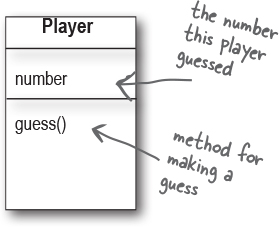
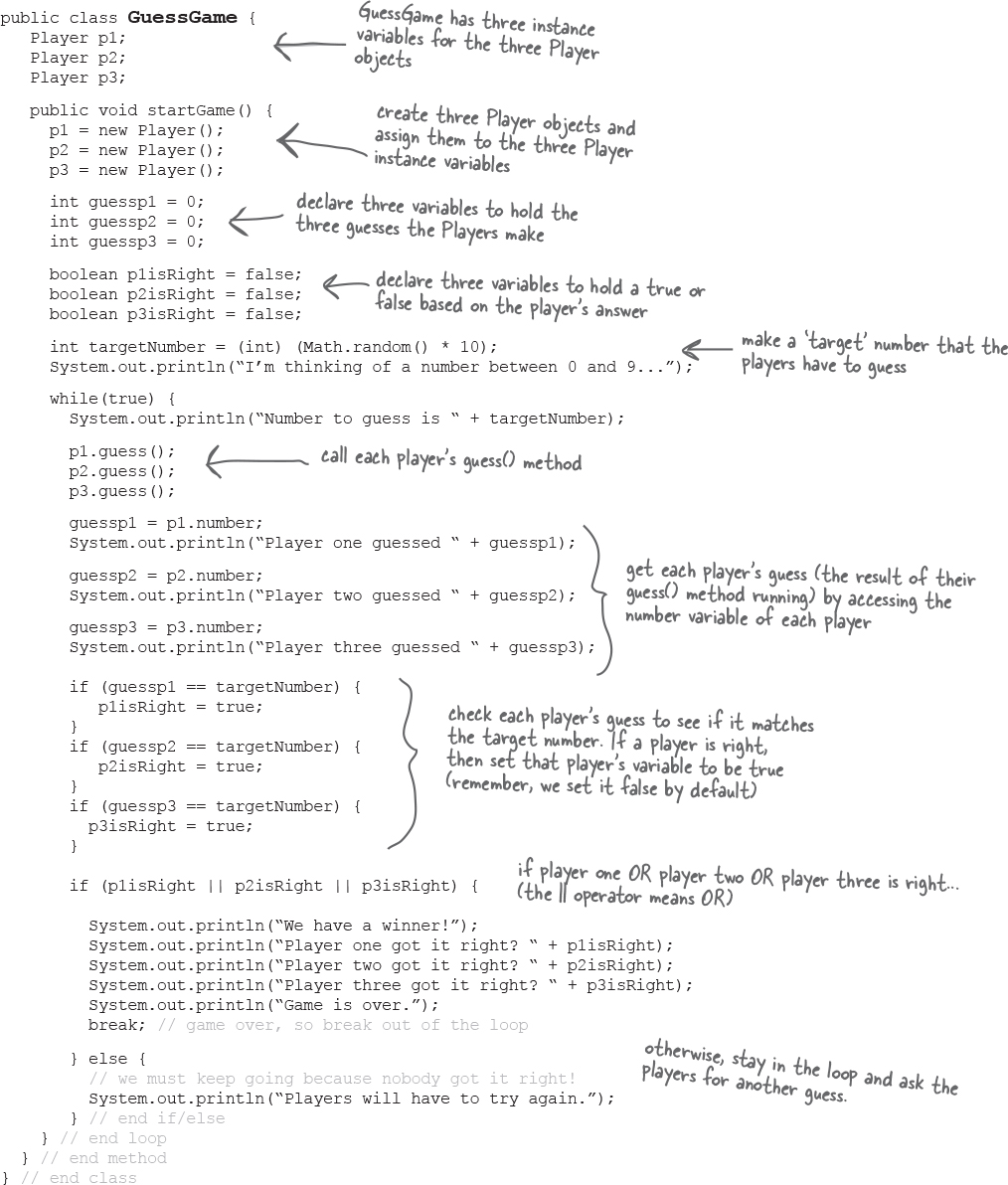
Running the Guessing Game
public class Player {
int number = 0; // where the guess goes
public void guess() {
number = (int) (Math.random() * 10);
System.out.println("I’m guessing "
+ number);
}
}
public class GameLauncher {
public static void main (String[] args) {
GuessGame game = new GuessGame();
game.startGame();
}
}
Output (it will be different each time you run it)

There are no Dumb Questions
Q: What if I need global variables and methods? How do I do that if everything has to go in a class?
A: There isn’t a concept of ‘global’ variables and methods in a Java OO program. In practical use, however, there are times when you want a method (or a constant) to be available to any code running in any part of your program. Think of the random() method in the Phrase-O-Matic app; it’s a method that should be callable from anywhere. Or what about a constant like pi? You’ll learn in chapter 10 that marking a method as public and static makes it behave much like a ‘global’. Any code, in any class of your application, can access a public static method. And if you mark a variable as public, static, and final – you have essentially made a globally-available constant.
Q: Then how is this object-oriented if you can still make global functions and global data?
A: First of all, everything in Java goes in a class. So the constant for pi and the method for random(), although both public and static, are defined within the Math class. And you must keep in mind that these static (global-like) things are the exception rather than the rule in Java. They represent a very special case, where you don’t have multiple instances/objects.
Q: What is a Java program? What do you actually deliver?
A: A Java program is a pile of classes (or at least one class). In a Java application, one of the classes must have a main method, used to start-up the program. So as a programmer, you write one or more classes. And those classes are what you deliver. If the end-user doesn’t have a JVM, then you’ll also need to include that with your application’s classes, so that they can run your program. There are a number of installer programs that let you bundle your classes with a variety of JVM’s (say, for different platforms), and put it all on a CD-ROM. Then the end-user can install the correct version of the JVM (assuming they don’t already have it on their machine.)
Q: What if I have a hundred classes? Or a thousand? Isn’t that a big pain to deliver all those individual files? Can I bundle them into one Application Thing?
A: Yes, it would be a big pain to deliver a huge bunch of individual files to your end-users, but you won’t have to. You can put all of your application files into a Java Archive – a .jar file – that’s based on the pkzip format. In the jar file, you can include a simple text file formatted as something called a manifest, that defines which class in that jar holds the main() method that should run.
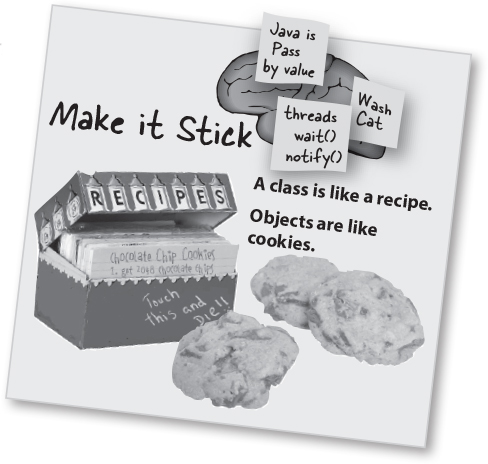

BE the compiler
Each of the Java files on this page represents a complete source file. Your job is to play compiler and determine whether each of these files will compile. If they won’t compile, how would you fix them, and if they do compile, what would be their output?

A
class TapeDeck {
boolean canRecord = false;
void playTape() {
System.out.println(“tape playing”);
}
void recordTape() {
System.out.println(“tape recording”);
}
}
class TapeDeckTestDrive {
public static void main(String [] args) {
t.canRecord = true;
t.playTape();
if (t.canRecord == true) {
t.recordTape();
}
}
}
B
class DVDPlayer {
boolean canRecord = false;
void recordDVD() {
System.out.println(“DVD recording”);
}
}
class DVDPlayerTestDrive {
public static void main(String [] args) {
DVDPlayer d = new DVDPlayer();
d.canRecord = true;
d.playDVD();
if (d.canRecord == true) {
d.recordDVD();
}
}
}

Code Magnets
A Java program is all scrambled up on the fridge. Can you reconstruct the code snippets to make a working Java program that produces the output listed below? Some of the curly braces fell on the floor and they were too small to pick up, so feel free to add as many of those as you need.



Pool Puzzle
Your job is to take code snippets from the pool and place them into the blank lines in the code. You may use the same snippet more than once, and you won’t need to use all the snippets. Your goal is to make classes that will compile and run and produce the output listed. Some of the exercises and puzzles in this book might have more than one correct answer. If you find another correct answer, give yourself bonus points!

Output

Bonus Question !
If the last line of output was 24 instead of 10 how would you complete the puzzle ?
public class EchoTestDrive {
public static void main(String [] args) {
Echo e1 = new Echo();
_________________________
int x = 0;
while ( ___________ ) {
e1.hello();
__________________________
if ( ____________ ) {
e2.count = e2.count + 1;
}
if ( ____________ ) {
e2.count = e2.count + e1.count;
}
x = x + 1;
}
System.out.println(e2.count);
}
}
class ____________ {
int _________ = 0;
void ___________ {
System.out.println(“helloooo... “);
}
}
Note
Each snippet from the pool can be used more than once!

![]()
A bunch of Java components, in full costume, are playing a party game, “Who am I?” They give you a clue, and you try to guess who they are, based on what they say. Assume they always tell the truth about themselves. If they happen to say something that could be true for more than one of them, choose all for whom that sentence can apply. Fill in the blanks next to the sentence with the names of one or more attendees. The first one’s on us.


Exercise Solutions
Code Magnets:
class DrumKit {
boolean topHat = true;
boolean snare = true;
void playTopHat() {
System.out.println("ding ding da-ding");
}
void playSnare() {
System.out.println("bang bang ba-bang");
}
}
class DrumKitTestDrive {
public static void main(String [] args) {
DrumKit d = new DrumKit();
d.playSnare();
d.snare = false;
d.playTopHat();
if (d.snare == true) {
d.playSnare();
}
}
}

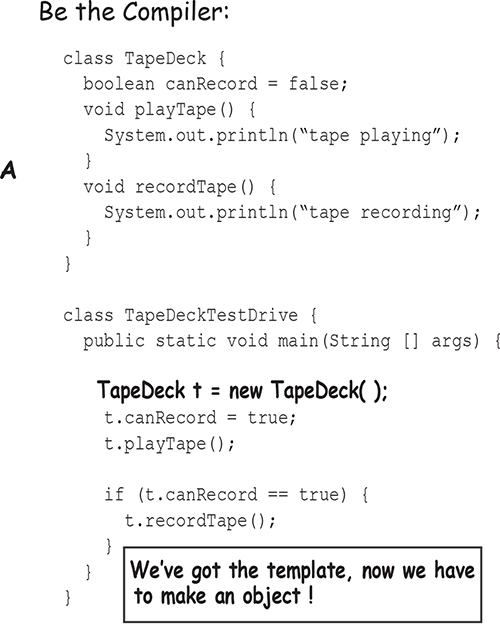

 Puzzle Solutions
Puzzle Solutions
Pool Puzzle
public class EchoTestDrive {
public static void main(String [] args) {
Echo e1 = new Echo();
Echo e2 = new Echo( ); // correct answer
- or -
Echo e2 = e1; // bonus “24” answer
int x = 0;
while ( x < 4 ) {
e1.hello();
e1.count = e1.count + 1;
if ( x == 3 ) {
e2.count = e2.count + 1;
}
if ( x > 0 ) {
e2.count = e2.count + e1.count;
}
x = x + 1;
}
System.out.println(e2.count);
}
___________________________________________________________
class Echo {
int count = 0;
void hello( ) {
System.out.println(“helloooo... “);
}
}
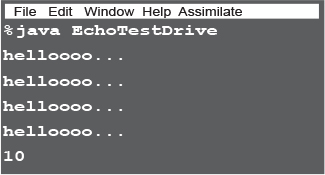
Who am I?
| I am compiled from a .java file. | class |
| My instance variable values can be different from my buddy’s values. | object |
| I behave like a template. | class |
| I like to do stuff. | object, method |
| I can have many methods. | class, object |
| I represent ‘state’. | instance variable |
| I have behaviors. | object, class |
| I am located in objects. | method, instance variable |
| I live on the heap. | object |
| I am used to create object instances. | class |
| My state can change. | object, instance variable |
| I declare methods. | class |
| I can change at runtime. | object, instance variable |
Note
both classes and objects are said to have state and behavior. They’re defined in the class, but the object is also said to ‘have’ them. Right now, we don’t care where they technically live.
